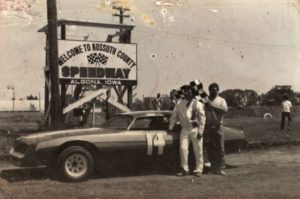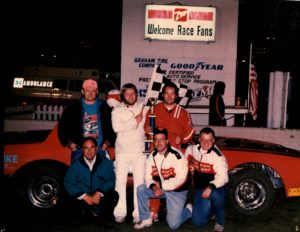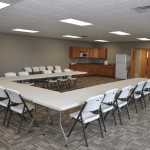By Chad Meyer
Greg Hilbert’s racing career started in 1986, when he and his cousin, Rob Jorgenson, put together a Monte Carlo to race. “The fact that my dad raced and the Algona track suddenly reopened, that was my motivation for building a car with Rob and starting to race,” Hilbert said. “I had just started at Snap On and had a little money. We were excited to get started.”
Though his father, the late Don “Shiney” Hilbert, was a stout racing competitor in his day, Shiney did not immediately warm up to his son’s entrance into the sport. “At first, he didn’t want anything to do with it. But once that Monte Carlo hit the track, he was all in, always asking ‘what do you need,’” Hilbert recalled.
The first car was numbered seven. The next year, they went with the family number of 14. “I don’t remember why we picked seven as the number, maybe because it was half of 14. My dad chose his number because it was A.J. Foyt’s number,” Hilbert remembers.
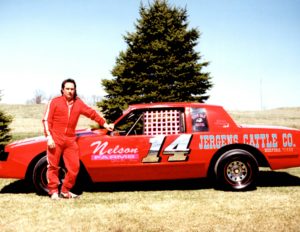 Hilbert was always hands on, even from the start. “We built these cars from scratch. Our first car had a 2-speed Powerglide transmission and a 402 CI big block. I could hardly hold on to it. It literally hop through the corners.”
Hilbert was always hands on, even from the start. “We built these cars from scratch. Our first car had a 2-speed Powerglide transmission and a 402 CI big block. I could hardly hold on to it. It literally hop through the corners.”
“One night I beat my uncle, Gene Schattschneider, in a heat race and afterwards he ran over to my car and said ‘Wow, you did a great job hanging on to that thing! Great race!’ That meant so much to me that he was proud of me. Those first couple years, we didn’t know what we were doing, but we tried hard, and Gene’s support meant a lot.”
The 1989 season marked a turning point in Hilbert’s young racing career. “Dick Gustin built that first red Monte Carlo we ran. We hauled that car down and back on a $400 open trailer and an old vintage panel truck,” Hilbert recalled.
“My dad and split time in 1989, alternating driving that car every other week. Ultimately, dad hung up his helmet because he was so scared of wrecking it and then we’d have to fix it,” Hilbert said.
The stock cars that he campaigned next were built Hilbert himself, with some help from Chuck Crimmins. “After work most nights, I’d head to Fort Dodge at Chuck’s shop. I’d weld up the cage and the frame and then we finished it here in Algona.”
It didn’t take long for the Hilbert team to be known as fast and for having a great looking car. “Our trademark was having a beautiful car. The driving was a bonus for me. Building them was the most fun. With those cars, you didn’t need to be an engineer to drive or build them. Our philosophy was that you built a car and put a strong motor in it.”
The competition at Algona helped Hilbert quickly raise his game. “When you raced Algona, it was like racing for a championship every week. The battles we had with David Wickman and Kevin Berte were epic! Winning the bounty they put on Berte at Algona was a pretty cool feat, too.”
Hilbert remembers several highlights of his career. “I was really proud to win what I think was the first Simpson Memorial held at Alta. I was even more proud to win the very first Schattschneider Memorial in Algona in 1994.”
He was the winner of both races in one week during the 1991 Kossuth County Fair. “That was always a big deal,” he said. “We won the Stock Car Nationals at Fairmont one year. We drew the pole and nobody touched us all night. The power steering line broke and there was a bunch of smoke. We were so far in front that the officials left us alone.”
Running Fairmont was fun for Hilbert. “We’d get done racing and the fans would swarm our car. We had a lot of fans there.”
He remembers a track championship that got away at Algona. “The last night, I was a few points behind the leader and we blew our motor to start the night. Dick Manske loaned us his car. I drove from the back to third and we were going to win the race and the championship. But, someone got in to me and cut my tire. That would’ve been a pretty storybook ending, but it didn’t’ happen.”
With success, came rumors of cheating. “I remember going to the Iowa State Fairgrounds for what was called ‘The Money Race.’ When I got to the gate, the IMCA official rode the trailer all the way into the pits. He measured everything, and then said we were legal,” laughed Hilbert. “The track was really dry and in the second half of the race we lost a plug wire. The car really started to come around and we got fifth place and $900.”
The first ever race at the newly constructed Hancock County Speedway in Britt in 1995 was memorable for both the racing and for what happened after.
“That first night at Britt, we had a great battle with John Pletcher. Back and forth the entire race. At the end, he beat me by a bumper, but I was the one was claimed. That was the beginning of the end of my career. We refused the claim and I never raced IMCA again. We just reached the point where it’s not how we wanted to race. We believed in building your own stuff and racing it.”
The last couple of years, Hilbert raced primarily at Fairmont and Webster City, which at the time, were not sanctioned by IMCA. “We like racing there, especially at Fairmont. But, we were driving past our home track of Algona to race and it wasn’t that much fun anymore.”
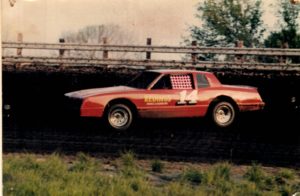 Hilbert is grateful for the support he received over the years. “If it wasn’t for our fans and the crew, we wouldn’t have done it as long as we did. Their support was tremendous.”
Hilbert is grateful for the support he received over the years. “If it wasn’t for our fans and the crew, we wouldn’t have done it as long as we did. Their support was tremendous.”
Though he may have retired from racing, he has never stopped building cars. “Building the vintage car that resembled my dad’s car was really good for me. It was a really emotional experience, especially after surviving cancer.” Hilbert’s latest project is leading the restoration efforts of Trostle sprint car chassis #101, which is owned by the Kossuth County Ag & Motorsports Museum.
Today, Hilbert and his Denise reside south of Hobarton, IA, where there is always at least one vehicle project in the shop.
Hilbert joins his father, Don “Shiney” Hilbert, as the first father-son inductees into the Kossuth County Racing Hall of Fame.
